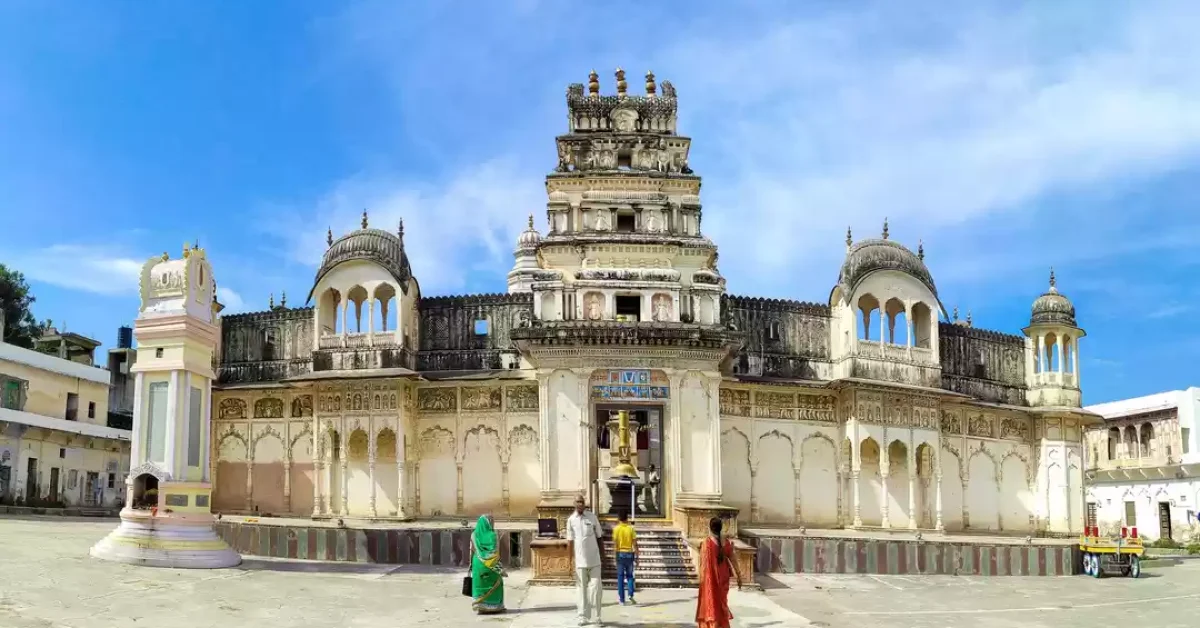The Pushkar Temple History, situated in the Pushkar town in Rajasthan is one of the sacred sites for the Hindus. It also houses the global rarity, a Lord Brahma temple, the god of creation in the Hindu pantheon. Its construction is known to have started in the 14th century, with additions being made several other times to date.
Located on the famous Pushkar Lake, the temple draws hundreds of devotees and visitors coming to bless themselves and to explore the temple’s architecture. The primary religious event of the temple starts in October or November in the form of the Brahma festival. This forms a part of the celebrated Pushkar Camel Fair.
Due to its religious importance and beautiful surroundings, the Pushkar Temple History is noteworthy and unique for visitors interested in spirituality and the culture of the country.
Architecture and structure
The architecture of the Pushkar temple history notably the Brahma temple signifies the architectural exploration influencing this archeological city. Bhrama temple was constructed in the 14th century. It has traditional Rajasthani-styled architecture like carvings, marble, and stones and its red royal cupola or shikhara. Garbhagriha, the sanctum sanctorum of the temple contains the deity Lord Brahma seated with four heads facing the four directions.
There is also a mandapa, which is a hall with pillars or columns used for prayer and various other ceremonies. The structure itself contains and has various images and idols of different Hindu gods and goddesses which are all detailed and have their corresponding significances. To boost the temple architecture, it has a stunning main entrance or torana that provides an entrance to the temple courtyard.
There are several other shrines around the Brahma Temple and each shrine has a different style of architecture. There are 52 ghats in Pushkar Lake surrounding the temples and pavilions making for a devout setting. These ghats are especially important as religious structures traditionally associated with the operations of the temple during the held every year Pushkar fair.
Why is Brahma ji worshipped in Pushkar?
Two main beliefs explain why Brahma ji is worshipped in Pushkar according to Pushkar Temple History:
Temple Legend:
One folklore particularly claims that the temple of Pushkar was selected by Brahma ji himself to reside in. The deity of Brahma Ji is revered in Pushkar for a rich and deeply rooted mythological connection attributed to the existence of the town. In terms of the Hindu creation account, Lord Brahma who was considered as the god of creation once looked for a suitable land to conduct a yagna. With one hand, he squeezed a lotus flower, releasing it in the air when its pedals touched the ground, he created lakes. The actual middle petal that dropped off the lotus flower fell in Pushkar and hence Brahma performs his yagna here.
There, he offered what is called yagna, or fire ritual with his wife, Saraswati. But Saraswati could not come on time. So Brahma ji conferred the ritual of marriage to a local Gurjar girl, Gayatri. When Saraswati arrived, she became infuriated and cast a curse on Brahma Ji. The curse entailed that he would not be even honored in Pushkar.
Curse of Shiva:
One myth is that there is one which tells that Brahma ji had once cheated about attaining the top of a pillar of light amidst rivalry with Vishnu. Shiva witnessed the event and understood the reality of the issue. He cursed Brahma ji that he would be deprived of having many temples to himself. According to the tradition, this temple of Pushkar is an exceptional structure.
Who built the Brahma Temples in Pushkar?
Visiting the oldest temple of Lord Brahma at Pushkar is also an appeal for tourists. This temple was originally built by the sage Vishwamitra in the earlier half of the fourteenth century. However, according to the Pushkar Temple History, the new structure was rebuilt and renovated. The renovation took place in the 18th century by the rulers of the Rajputana region Maharaja Jawat Raj of Ratlam. There have been instances where the temple was reconstructed or enlarged from time to time. This was done with support from the kings and other devotees to conserve the temple and its beautiful structures.
Of all the donors, Maharaja Jawat Raj was the most beneficial to the temple. It was due to the fact that he rebuilt the structure after its dilapidation. Because of him, the temple remains one of the most important pilgrimage destinations for people who believe in Lord Brahma. The continued relevance and purpose of the temple, as well as its maintenance, signify the commitment of multiple patrons to the preservation of the temple as a religious and cultural site in Pushkar.
Famous Temples in Pushkar
Located just on the banks of the Pushkar Lake, the enchanting town of Pushkar is one of the most sacred Hindu pilgrim destinations. It is a town that is said to be blessed with more than 500 temples and this gives the town a pulsating energy. Here are some of the most famous temples that attract the devotees and tourists alike:
Brahma Temple:
This red sandstone temple, which is devoted to Lord Brahma, the God of creation, is the only well-known Brahma temple in India. Whether it is a legend or a history, its importance cannot vanish, so the site has to be viewed as an indispensable point of interest for any Pushkar pilgrimage.
Varah Temple:
Known as Varaha Temple the elegant temple of Lord Vishnu is one of the oldest temples that exists in Pushkar now. A lot of interesting sculptures on the stones and several pillars are evidence of the Indian architectural development of ancient times.
Savitri Temple:
This temple is located on Ratnagiri Hill and is devoted to Savitri Mat. She is known to be the wife of Brahma Ji. To get to the temple one has to climb through a picturesque path. It is richly viewed by the wide terrains of Pushkar Lake and the township.
Rangji Temple:
This colorful temple with beautiful carvings and paintings enshrines Lord Rangji who is an avatar of Lord Vishnu. It has an exquisite blend of the Rajput and the Mughal styles of architecture and therefore is eye-pleasing.
Aptaeshwar Temple:
It is a temple that is situated close to the Pushkar Lake. It is the most revered temple that is an underground temple devoted to Lord Shiva. Worshippers consider that a ritual washing in the kund located in the temple precincts washes away sins.
FAQ
The Brahma Temple located in Pushkar is very significant because it is the only major temple of Lord Brahma in the whole of India. This makes it a unique and very sacred site for pilgrimage.
The Brahma Temple in Pushkar, Rajasthan, has a unique restriction: specifically men who are married to other women are barred for entry to the inner chamber. This rule stems from a legend associated with the temple:
While Lord Brahma who is known as the god of creation worshiped at a fire altar in the Pushkar Lake. His wife Saraswati was not available, so to perform the Yagya he had to marry another woman by the name of Gayatri. This made Saraswati angry, so when she arrived she cursed the temple and it all followed. It goes further explaining that once any married man sets his feet in the inner part, he will encounter issues in his marriage.
As a result, for many years it was forbidden for married men to enter the inner part of the Brahma Temple.
According to Hindu mythology, there is a legend associated with why Lord Brahma is primarily worshipped only in Pushkar.
The Curse of Savitri:
Pushkar, the most sacred place for the Hindus witnessed a Yagna by Lord Brahma, the god of creation. His wife, Savitri, was a little late. After the completion of the ritual, Brahma went further and married yet another woman called Gayatri. When she saw this, Savitri came and fumed.
She cursed Brahma to the effect that he would be worshipped only in Pushkar.
This legend describes why, out of all Hindus celebrating trinity, Lord Brahma is worshipped at only one major temple in India.
The best time to visit the Pushkar temple is during February the Pushkar Camel fair usually happens in October or November. Nevertheless, the temple can be visited at any time of the year.


